![]()
![]()
![]()
Use LEFT and RIGHT arrow keys to navigate between flashcards;
Use UP and DOWN arrow keys to flip the card;
H to show hint;
A reads text to speech;
67 Cards in this Set
- Front
- Back

|
Cadena de amor (collenchyma tissues) |
|
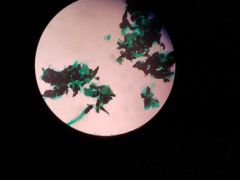
|
Stone cells (sclereids) |
|

|
Helianthus stem (reticulated vessels, annular vessels, spiral vessels, pitted vessels) |
|

|
Alium cepa root (meristematic tissue) |
|
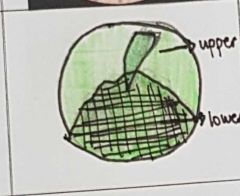
|
Tilia leaf (upper and lower epidermis) |
|
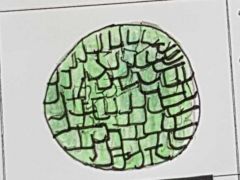
|
Vicia faba (parenchyma tissues) |
|

|
Tangential section of wood (tracheids, vascular ray) |
|

|
Cork (cork cells) |
|
|
In 1858, a scientist named ____ reasoned that existing cells had to arise from other preexisting cells. |
Virchow |
|
|
In plants, only certain types of cells called ____ cells are normally capable of dividing to form new cells. These cells are usually restricted to certain locations within the plant such as the tips of ____ and ____ |
meristematic roots shoots |
|
|
The nucleus of the existing cells divides to form 2 nuclei is called ____ |
mitosis |
|
|
A cell plate forms that separates the two nuclei forming 2 new cells from the pre existing cells is termed as ____ |
cytokinesis |
|

|
Interphase |
|

|
Prophase |
|

|
Metaphase |
|

|
Anaphase |
|
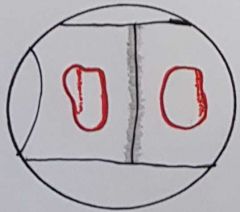
|
Telophase |
|

|
Cytokinesis |
|

|
Cellular reproduction |
|
|
Lignified cell walls usually will be stained ____, whereas cell walls composed mainly of ____ will be stained with some shade of blue or green |
red cellulose |
|
|
These are found at the tip of roots and shoots which produce new cells to increase the length of the root or shoot |
Apical meristems |
|
|
These cells are a single superficial layer of cells covering all other primary tissues which are derived from the apical meristems |
Epidermal cells |
|
|
These cells protect the underlying tissues |
Epidermal cells |
|
|
Cells tend to have large vacuoles and may contain various secretions |
Parenchyma cells |
|
|
2 Clsssification of parenchyma cells |
Aerenchyma cells-have extensive connected air space Chlorenchyma cells-contain chloroplasts |
|
|
These are green pigments |
chloroplasts |
|
|
Elongated cells that provide excellent support and strengthening functions being located just beneath the epidermis and thickened at the corners |
Collenchyma cells |
|
|
Cells that support and protect due to the shape, thickness and toughness of their cell walls on which are deposited with lignin |
Sclerenchyma cells |
|
|
2 Classifications of Sclerenchyma cells |
Sclereids-isodiametric cells Fibers-elongated cells with pointed ends |
|
|
These are made up of vessel elements which are long tubes that are open at each end. Their walls are thickened forming a secondary wall that is deposited in different patterns |
Vessels |
|
|
5 types of vessels |
1. Reticulate vessels 2. Annular vessels 3. Spiral vessels 4. Pitted vessels 5. Sclariform vessels |
|
|
vessels wherein the lignin forms a network on the walls |
reticulate vessels |
|
|
in this type of vessel, the lignin deposits appear as separate rings |
annular vessels |
|
|
in this type of vessel, the lignin is laid down as spiral bands |
spiral vessels |
|
|
in pitted vessels, the walls are ____ |
pitted |
|
|
vessels that have the thickenings in the form of transverse, interconnecting bars |
Sclariform vessels |
|
|
these are tubes that are tapered at each end, with pits that allow passage of water between cells |
tracheids |
|
|
these are important for lateral short-distance conduction |
Rays |
|
|
These are flattened, thin-walled cells with little or no intercellular spaces |
Cork cells |
|
|
These cells make up the periderm that constitutes the outer bark of a woody stem |
Cork cells |
|
|
3 types of meristematic tissue |
1. Apical - for plant length 2. Lateral - for secondary growth and diameter 3. Intercalary - found at the basal portiom |
|
|
3 vegetative organs |
the root, the stem and the leaves |
|
|
flowering plants is also known as |
angiosperms |
|
|
2 broad classes of angiosperms |
dicot and monocot |
|
|
corn seeds and bean seeds should be about ___ inches tall |
7 |
|
|
example of a dicot plant |
balatong SN: Glycine max |
|
|
4 Different root systems |
1. Fibrous 2. Taproot 3. Fleshy root 4. Fascicled root |
|

|
Dicot seed |
|

|
monocot seed |
|

|
dicot root cross section |
|

|
dicot root |
|

|
monocot root |
|
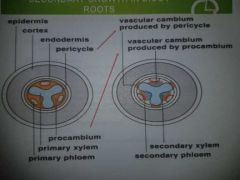
|
dicot root |
|
|
2 Classification of stems |
woody herbaceous |
|

|
dicot c.s. |
|
|
function of stems (CSPFP) |
1. Conduction of materials 2. Support for aerial plants 3. Production of leaves, branches, and new shoots 4. Food storage 5. Photosynthesis |
|
|
a stem that is long coiling structures that function for attachment and support of a climbing plant |
Tendrils |
|
|
stems with long internodes that move in circles through the air seeking support |
Searcher roots |
|
|
horizontally oriented stems that grow along the soil surface and function for vegetative reproduction due to the formation of roots at the nodes |
Stolons |
|
|
modified stems that protect the plant from grazers |
Thorns |
|
|
flat, leaf like stems modified for photosynthesis |
Cladophylls |
|
|
Hollow or solid stem of grasses with distinct nodes ans internodes |
Culms |
|
|
stem that store large amount of water, common with plants in desert areas |
Succulent stems |
|
|
large underground stems, roundish bud with a small basal stem at its lower part and its bulk being made of thickened scales which store nutrients |
Bulb |
|
|
stubby, short, fleshy, vertically oriented stems that store nutrients |
corms |
|
|
underground stems that grow near the soil surface and have short internodes bearing scales |
Rhizomes |
|
|
swollen regions of stems that store food; they bear buds called "eyes" |
tubers |

